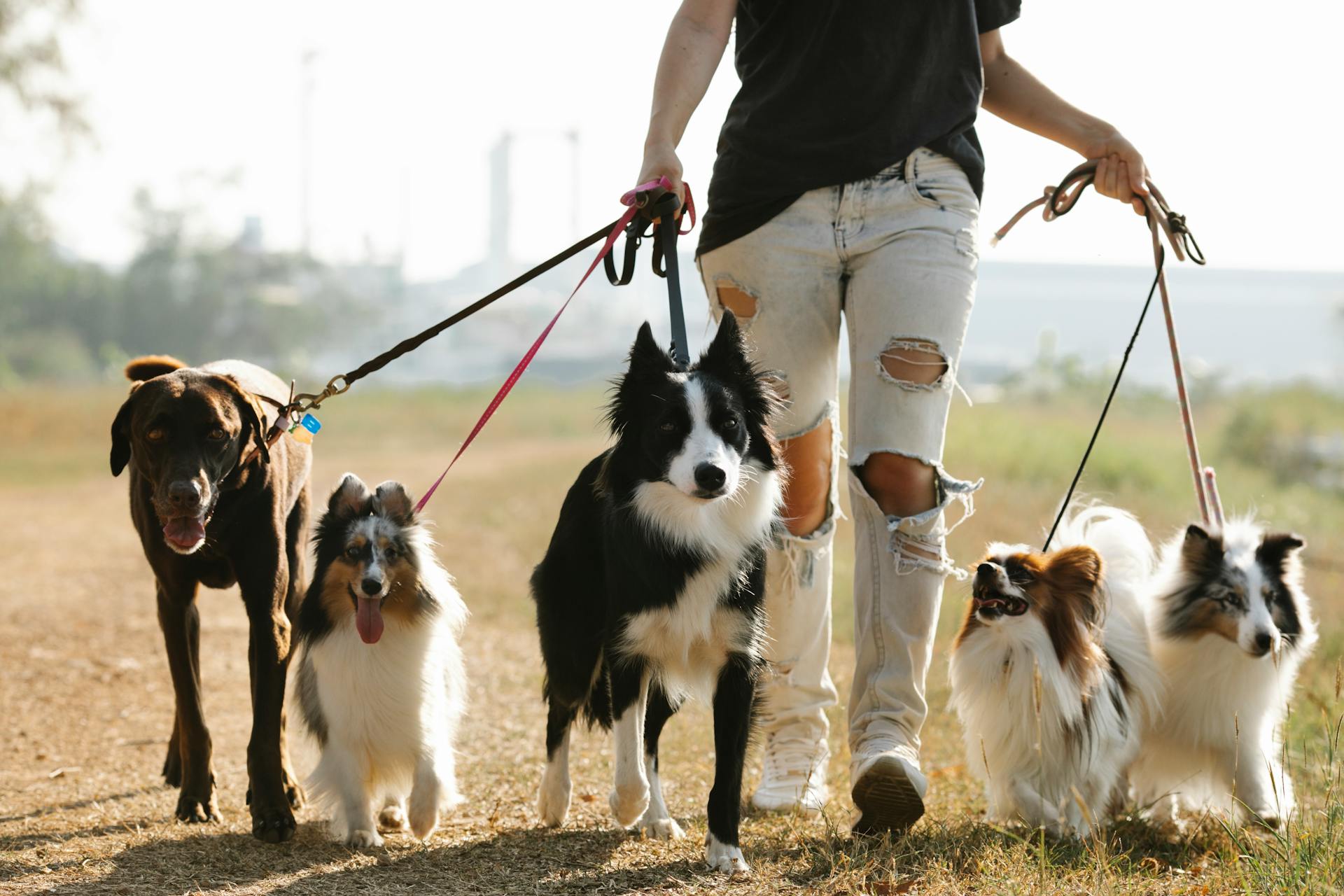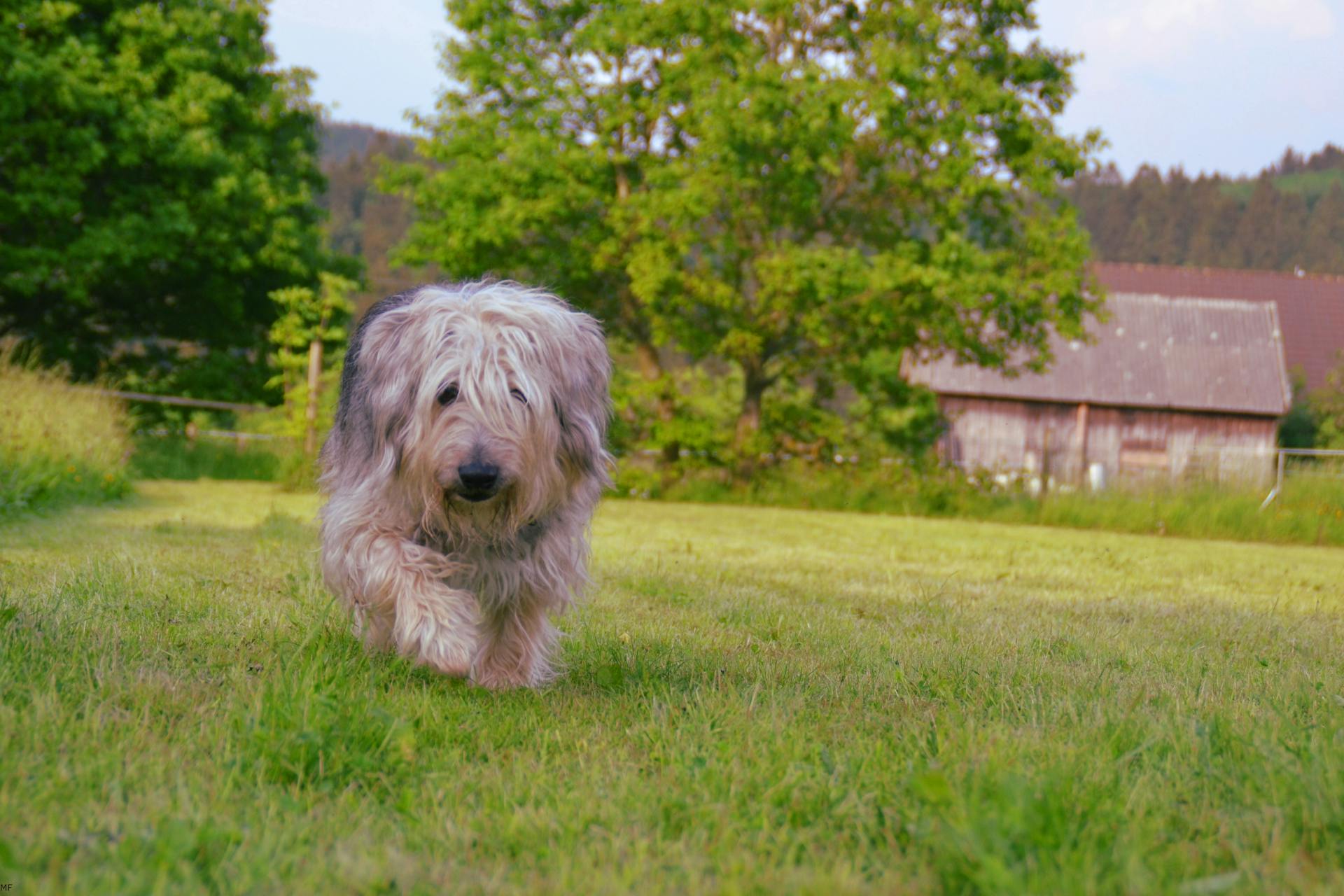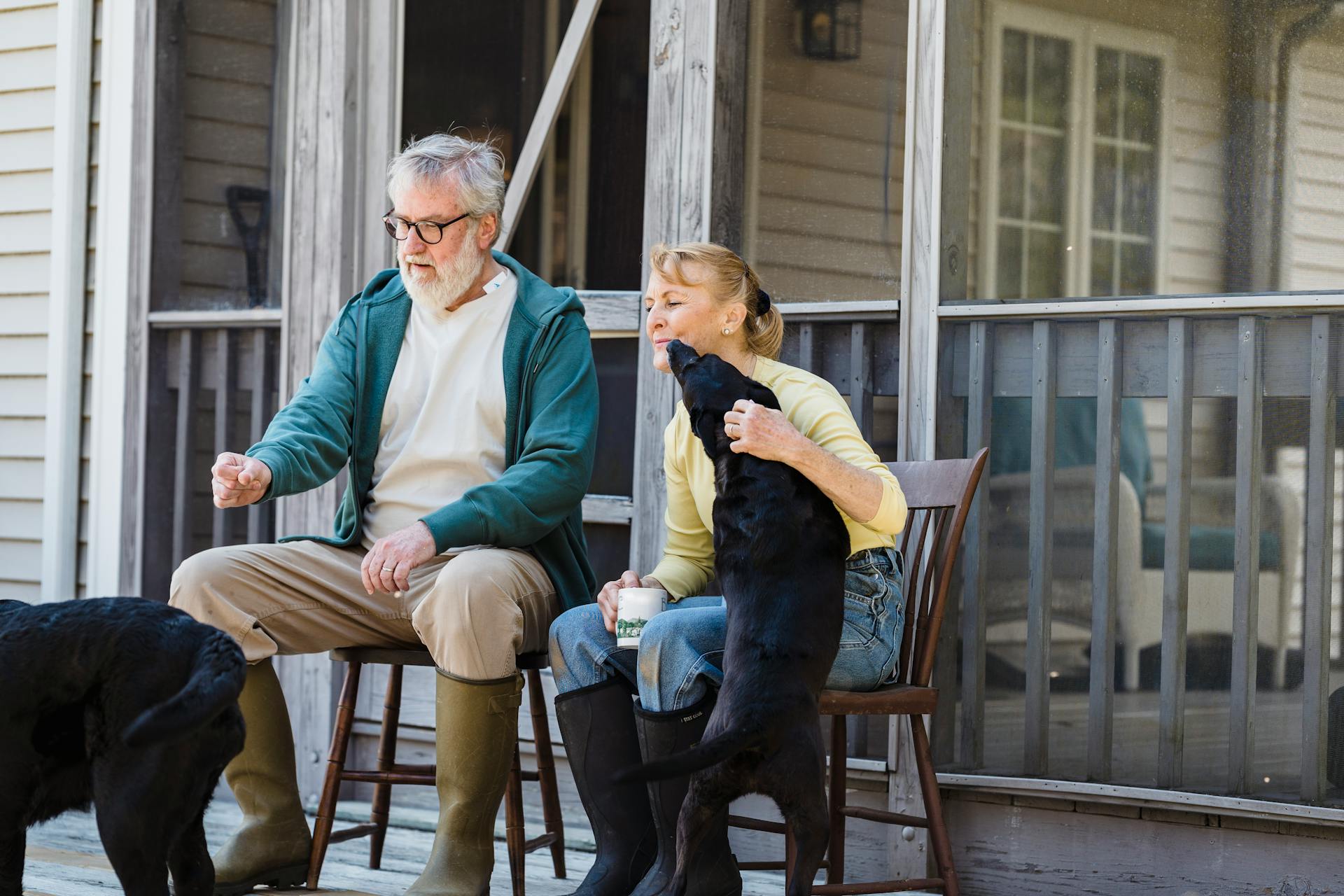
Velcro dogs are known for their strong attachment to their owners. This attachment can be intense, with some dogs following their owners everywhere and even sleeping next to them.
One of the key characteristics of velcro dogs is their desire for physical contact. They often prefer to be in close proximity to their owners, with many dogs enjoying being petted or cuddled.
Recommended read: How to Remove Dog Hair from Velcro
Velcro Dog Characteristics
A velcro dog is a dog that's extremely attached to its owner. They love to be close to you and will often follow you around the house, even between rooms.
Some common behaviors of a velcro dog include following you around a room, or between rooms. They're always watching you and what you're doing, which can be a bit much at times.
Velcro dogs also tend to sit or sleep as close to you as possible. This is because they're highly attentive to your moods and try to anticipate your movements.
Here are some specific characteristics of a velcro dog:
- Following you around a room, or between rooms
- Always watching you and what you are doing
- Sitting/sleeping as close to you as the possibly can
- Highly attentive to your moods
- Tries to anticipate your movements
Training a Dog to Come When Called
Training a dog to come when called is essential for any dog owner, especially those with velcro dogs. You can start by teaching your dog the 'Stay' or 'Wait' command, which can help them understand that they don't need to follow you everywhere.
This command can be taught using positive training methods, such as those advocated by Zak George. His videos on teaching dogs to stay are a great resource for beginners. Just remember to be consistent and patient, as this process can take time.
As your dog learns to stay, they'll also learn that even when you walk away, you'll always be back, often with a treat in hand. This can help reduce their clinginess and give them a sense of security.
Remember, velcro dogs are not necessarily suffering from separation anxiety, but rather a strong attachment to their owner. By setting boundaries and encouraging healthy alone time, you can help your dog become a well-behaved and loving pet.
To further reduce clinginess, make sure your dog is getting enough physical exercise and mental stimulation. Problem-solving exercises, obedience work, and even simple games like hide and seek can help keep their brain active and prevent boredom.
For more insights, see: All about Dogs Dog Training
Breed-Specific Information
Labrador Retrievers are often considered Velcro dog breeds, but it's essential to remember that the trait can vary among individual dogs regardless of breed.
Golden Retrievers are also known for their Velcro behaviors, making them a popular choice for families who want a loyal companion.
German Shepherds are another breed that can be prone to Velcro behaviors, but it's crucial to provide them with enough exercise and mental stimulation to prevent separation anxiety.
Cavalier King Charles Spaniels are known for their affectionate nature, often making them Velcro dogs that stick close to their owners.
Regardless of breed, it's essential to remember that every dog is an individual, and their Velcro tendencies can vary.
Expand your knowledge: Velcro Dog Breed
Understanding Velcro Dog Behavior
A Velcro dog is a dog that's especially clingy and attached to its owner. They tend to follow their owners everywhere, seeking constant attention, affection, and reassurance.
This behavior can be based on dog anxiety or learned through interaction with their owner. Consistently praising and rewarding a dog for being clingy can encourage the behavior to continue.
Dogs are pack animals, so it's natural for them to want to be near their human pack leader. However, a Velcro dog takes clinginess to the next level, becoming almost a compulsion.
Some common reasons for Velcro dog behavior include a dog's natural instinct to be part of a pack, socialization, and early bonding experiences. Past traumas, such as abandonment, can also cause a dog to become clingy.
Here are some Velcro dog characteristics to look out for:
- Following you around a room, or between rooms
- Always watching you and what you are doing
- Sitting/sleeping as close to you as possible
- Highly attentive to your moods
- Tries to anticipate your movements
These behaviors can get frustrating over time, but understanding the underlying causes of Velcro dog behavior is key to addressing it effectively.
Understanding Pack Mentality
Dogs are social animals that have evolved to live in groups, known as packs. Within a pack is a hierarchical structure where each dog has a specific rank.
A dog's pack mentality is the set of behaviors and social interactions that dogs use to establish and maintain this hierarchy within their group. In a healthy pack, all members understand and respect their place within the hierarchy, and conflict is minimized.
Dogs in a pack also tend to work together to achieve common goals, such as hunting or defending their territory. This natural instinct to be part of a pack is still present in domesticated dogs.
Your furry friend sees their human family as their pack, which is why some dogs will choose to follow whomever they perceive as the protector of the pack. This is especially true for Velcro dogs, who become extremely attached to their owners.
Here are some key characteristics of a dog's pack mentality:
- Body language and vocalizations are used to convey position within the group
- Dogs work together to achieve common goals
- A healthy pack has a clear hierarchical structure
- Dogs respect and understand their place within the group
Understanding a dog's pack mentality can help pet owners better communicate and bond with their furry friends and also prevent potential conflicts with other dogs. By recognizing the pack mentality, you can provide a more stable and loving environment for your dog.
Assisting Seniors
As your dog ages, they may become clingier and more reliant on you, which can be a natural response to losing their hearing and vision. Dogs can become disoriented and frightened by these changes.
Curious to learn more? Check out: How Do You Become a Dog Trainer for Service Dogs
Keeping the house well-lit can help your dog navigate more easily. This is especially important if their eyesight is going.
Avoid making sudden or drastic changes to the layout of the house, as this can be confusing for your dog. They've probably memorized the layout, so try to keep things as consistent as possible.
Stimulating your aging dog's mind with puzzles and toys can help keep their brain sharp and support their brain health.
On a similar theme: Why Does My Male Dog Keep Licking My Female Dog
Managing Velcro Dog Behavior
Providing your dog with proper socialization is key to managing velcro behavior. Socialization helps build confidence in being alone at times.
You can manage velcro behavior by providing your dog with training and opportunities for independent play and exercise. This will help your dog become more confident and relaxed.
Desensitizing your dog is a crucial step in managing velcro behavior. Start by moving a small amount and when your dog doesn't move, return to them and praise them.
It takes time and patience to desensitize your dog, so use very small intervals and don't go too far at once. This will help your dog understand that it's okay to stay where they are.
If your dog's velcro behavior is rooted in anxiety or fear, natural calming solutions might help reduce the stress that's triggering their needy behavior.
Specific Breeds
Some dog breeds are naturally more clingy than others. The Labrador Retriever is often referred to as a Velcro dog due to its love of snuggling with its humans.
Labrador Retrievers are surprisingly clingy, and their owners often notice this behavior. They tend to follow their owners around the house and become anxious when left alone.
The Great Dane is another breed that can exhibit Velcro behavior, especially after experiencing trauma or abuse. They can become extremely attached to their owners and may even try to escape from their surroundings to stay close.
Here are some Velcro dog breeds to consider:
- Labrador Retriever
- Great Dane
- German Shepherd
- Cavalier King Charles Spaniel
- Pit Bull
15 Breeds
If you're considering getting a dog, it's essential to know that some breeds are naturally more clingy than others. Certain breeds, like the Labrador Retriever, are often referred to as "Velcro dogs" due to their strong attachment to their owners.
Labradors are not the only breed that exhibits this behavior, however. Other breeds, such as the Golden Retriever, German Shepherd, and Cavalier King Charles Spaniel, are also known to be clingy. In fact, these breeds are often considered to be among the most affectionate and social in the world.
If you're looking for a breed that will stick by your side, you might want to consider one of the following:
- Labrador Retriever
- Golden Retriever
- German Shepherd
- Cavalier King Charles Spaniel
- Pug
- Chihuahua
- Doberman Pinscher
- Great Dane
- French Bulldog
- Shetland Sheepdog
- Italian Greyhound
- Maltese
- Border Collie
- Vizsla
- Mini Australian Shepherds
- Bichon Frise
- Boxer
- Cocker Spaniels
- Poodle
- Yorkshire terrier
Keep in mind that every dog is an individual, and while breed tendencies may be a good indicator of a dog's personality, it's essential to spend time with a potential new pet to understand its unique characteristics.
Great Dane
Great Danes are known for their gentle nature, but some can develop Velcro behavior, clinging to their humans and becoming anxious when left alone.
Their large size can make them escape artists, capable of easily slipping out of most spaces.
Great Danes can be quite skilled at finding ways to escape, with some learning to open doors and windows.
In some cases, they may even attempt to follow their owners out of the house, as seen in the case of Yeti, a Great Dane who would try to leave with his foster whenever she did.
With their large size and determination, it's no wonder Great Danes can be quite the handful for some owners.
Intriguing read: Indestructible Dog Toy for Large Dogs
Border Collie
Border Collies are highly intelligent and high-energy dogs that need an enormous amount of exercise and mental stimulation.
They can quickly become frustrated and anxious if they don't receive adequate time to release their energy. Without enough exercise, they often rely heavily on their humans for fun, comfort, and stimulation.
Many Border Collies develop separation anxiety, which can manifest in behaviors like whining or barking when left alone. Some owners have reported that their dogs will spend hours looking miserable through a window, waiting for their family member to return.
These breeds are known for their intelligence and desire to work alongside humans, which can make them clingy if they stray too far from their hardworking roots. They have a very strong sense of loyalty to their owners, making them prone to separation anxiety.
Recommended read: Dog Food for High Energy Dogs
Maltese
Maltese are very person-oriented dogs, happy to do everything with their chosen people.
They don't like being separated from their humans and will often try to escape if they're anxious.
These little dogs will put themselves in danger if they're feeling anxious, as Yodi the Maltese did when he made a break for it to be with his mom.
Maltese are known to be velcro dogs, meaning they love to be close to their people and can get anxious if they're apart.
Curious to learn more? Check out: Dog Boarding for Anxious Dogs
Vizsla
Vizslas are so devoted to their humans that their owners rarely get a chance to use the bathroom alone.
They thrive on routine and like to know their place in the world at all times. This can make them struggle to be left alone, especially if their routine is disrupted. My family's 2-year-old Vizsla is a perfect example of this - he has serious attachment issues and gets unsettled when his routine is changed.
The hunting breed is widely recognized to be among the most dependent on human companionship. They rarely leave their owners' sides and love to share time with them, especially if that time involves sports and physical activities.
Their athletic builds and serious expressions may not seem to match their clingy personalities, but it's a trait that's hard to ignore.
Italian Greyhound
Italian Greyhounds are the epitome of devotion, preferring the warmth of their human's side over any spot in the house.
They're often found burrowed under blankets or curled up in laps, always in close proximity to their beloved owners. Their slender frames are a testament to their love for snuggling.
Italian Greyhounds have large, expressive eyes that seem to hang on every word and movement, making them the perfect companion for those who cherish constant companionship.
Their clinginess can be both a blessing and a challenge, especially when it comes to separation anxiety. This can be a reminder of how deeply these dogs connect with their routine and their people.
Italian Greyhounds make it their mission to be involved in every aspect of their owner's life, embodying the true definition of a shadow by rarely letting you out of their sight.
Pug
Pugs are known for their remarkable loyalty and tendency to stick by their owners' sides with unshakeable devotion.
Their compact size and expressive faces make them a beloved companion. They thrive on human interaction and love being part of every aspect of their owner's life.
Pugs were bred as companions for emperors and the royal court in ancient China, dating back 2,000 years. They're still cherished today for their sweet, sensitive dispositions.
They have a strong need for human connection and do not like being left alone, making them a great fit for families or individuals who are home often.
German Shepherd
German Shepherds are known for being Velcro dogs, often considered to be one of the clingiest breeds out there.
They thrive on being an integral part of their owner's life, following them everywhere and demanding constant attention and care. Their need for companionship is profound, and separation can be challenging, leading to signs of separation anxiety like whining or scratching at doors.
German Shepherds were originally bred for herding, but can become "needy" when not challenged, leading to destructive behaviors or attempts to escape. They require a significant investment of time in activities that cater to their high energy levels and mental stimulation needs, such as daily walks, rigorous training sessions, and innovative games.
If not properly trained and socialized, German Shepherds can develop severe separation anxiety, which can be a real challenge for owners. Strategies like food puzzles or DIY interactive toys can offer temporary respite, allowing for moments of independence amidst a day filled with constant companionship.
For more insights, see: Are German Shepherd Dogs Good Family Dogs
Beagle
The Beagle is a small to medium-sized breed of dog that originated in England in the 15th century.
They were originally bred for hunting small game, such as rabbits and hares, and were known for their keen sense of smell and energetic hunting style.
Beagles typically weigh between 18 and 30 pounds and stand between 10 and 15 inches tall at the shoulder.
Their short coats require minimal grooming, making them a great choice for busy owners.
On a similar theme: Good Dog Food for Hunting Dogs
Pomeranian
Pomeranians are known for being extra snuggly and having an innate desire to be close to their favorite human.
They have a pampered pedigree, beloved by Queen Victoria, and were originally bred down from sledding and working Spitz-type dogs in Europe.
Pomeranians have a unique personality that makes them lap dogs through and through, never looking back from their role as pampered companions.
Their history and breeding make them a perfect fit for those who want a dog that will follow them everywhere.
Pit Bull
Pit Bulls are often very attached to their owners, but this is more likely related to their shelter experience and not an inborn trait.
Pit Bulls tend to have the longest shelter stays, which can make them prone to extreme separation anxiety, even after they are adopted.
Their Velcro behavior is a result of holding on tight to their new family members, a coping mechanism from their rescue experience.
This intense attachment can be overwhelming for some owners, but with patience and understanding, Pit Bulls can learn to thrive in their new environment.
Dachshund
Dachshunds are famous for their signature shape and often-mispronounced name.
Their Velcro tendencies are a defining characteristic, making them fiercely loyal low-riders who prefer to be with their families at all times.
Dachshunds are known for their intolerance for being left alone, which can make them difficult to have in a single-parent household.
Frequently Asked Questions
What is the difference between Velcro dogs and separation anxiety dogs?
Dogs with separation anxiety experience emotional distress and panic when left alone, whereas Velcro dogs may simply be upset when you leave the house
Do all Velcro dogs have separation anxiety?
Velcro dogs may exhibit apprehension when left alone, but not necessarily full-blown separation anxiety. They should be interested in your presence, but relaxed and self-sufficient when you're not around.
How to treat velcro in a dog?
To treat "velcro" in a dog, try increasing exercise, stimulating their mind, and creating a special space to reduce their attachment to you. Desensitizing your dog to your movements can also help break the habit of constant following.
Sources
- https://petcube.com/blog/velcro-dog-why-is-my-dog-so-clingy/
- https://rockykanaka.com/list/10-ultra-clingy-velcro-dog-breeds-that-will-neve-let-you-go-to-the-bathroom-alone/
- https://blog.homesalive.ca/dog-blog/velcro-dogs
- https://www.lifescarousel.com/velcro-dog/
- https://www.greatpetcare.com/dog-breeds/14-velcro-dog-breeds-that-cling-to-their-pet-parents/
Featured Images: pexels.com


